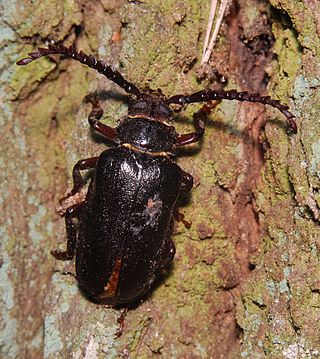
The longhorn beetles (Cerambycidae), also known as long-horned or longicorns, are a large family of beetles, with over 35,000 species described. Most species are characterized by extremely long antennae, which are often as long as or longer than the beetle's body. In various members of the family, however, the antennae are quite short and such species can be difficult to distinguish from related beetle families such as the Chrysomelidae. The scientific name of this beetle family goes back to a figure from Greek mythology: after an argument with nymphs, the shepherd Cerambus was transformed into a large beetle with horns.

Prionus coriarius is a species of longhorn beetle.

Powderpost beetles are a group of seventy species of woodboring beetles classified in the insect subfamily Lyctinae. These beetles, along with spider beetles, death watch beetles, common furniture beetles, skin beetles, and others, make up the superfamily Bostrichoidea. While most woodborers have a large prothorax, powderpost beetles do not, making their heads more visible. In addition to this, their antennae have two-jointed clubs. They are considered pests and attack deciduous trees, over time reducing the wood to a powdery dust. The damage caused by longhorn beetles is often confused with that of powderpost beetles, but the two groups are unrelated. The larvae of the Cerambycidae are white, straight and generally flat-headed, whereas those of the Bostrichidae are white and C-shaped.

Anaesthetis testacea is a species of longhorn beetle. It is a common species in Europe that develops in the dead, terminal twigs of deciduous trees and shrubs.

Callipogon relictus is a species of longhorn beetle which is mostly found in Korea, but also in China and southern part of Russian Far East. It inhabits mixed and deciduous forests. The population of Callipogon relictus is decreasing due to deforestation and uncontrolled collection, and therefore the species are listed in the Russian Red Book.

Dinoptera collaris is the species of the Lepturinae subfamily in long-horned beetle family.

Anaglyptus mysticus, the rufous-shouldered longhorn beetle, is a species of beetle belonging to the family Cerambycidae, subfamily Cerambycinae.

Chlorophorus sartor is a species of beetle of the family Cerambycidae, subfamily Cerambycinae.

Clytus rhamni is a species of round-necked longhorns belonging to the family Cerambycidae, subfamily Cerambycinae.

Pseudovadonia livida, the fairy-ring longhorn beetle, is a beetle species of flower longhorns belonging to the family Cerambycidae, subfamily Lepturinae.

Rutpela maculata, the spotted longhorn, is a beetle species of flower longhorns of the family Cerambycidae, subfamily Lepturinae.

Saperda punctata is a beetle species of flat-faced longhorns belonging to the family Cerambycidae, subfamily Lamiinae.

Stenurella melanura is a flower longhorn beetle species of the family Cerambycidae, subfamily Lepturinae.

Exocentrus adspersus is a species of longhorn beetles of the subfamily Lamiinae. It was described by Mulsant in 1846, and is known from Europe, the Caucasus, and Russia. The beetles inhabit various deciduous trees, although their preferred host plants are oaks. They measure 5–8 millimetres (0.20–0.31 in) long and can live for approximately 2 years.
Exocentrus ritae is a species of longhorn beetles of the subfamily Lamiinae. It was described by Sama in 1985, and is endemic to Turkey. The beetles inhabit deciduous trees. They measure 3–5 millimetres (0.12–0.20 in) in length, and can live for approximately 1–2 years.

Pogonocherus is a genus of flat-faced longhorn beetles in the family Cerambycidae.

Alosterna tabacicolor is a species of beetle in family Cerambycidae.

Grammoptera ruficornis is a species of beetle in family Cerambycidae.

Chlorophorus figuratus is a species of round-necked longhorns belonging to the family Cerambycidae, subfamily Cerambycinae.


















